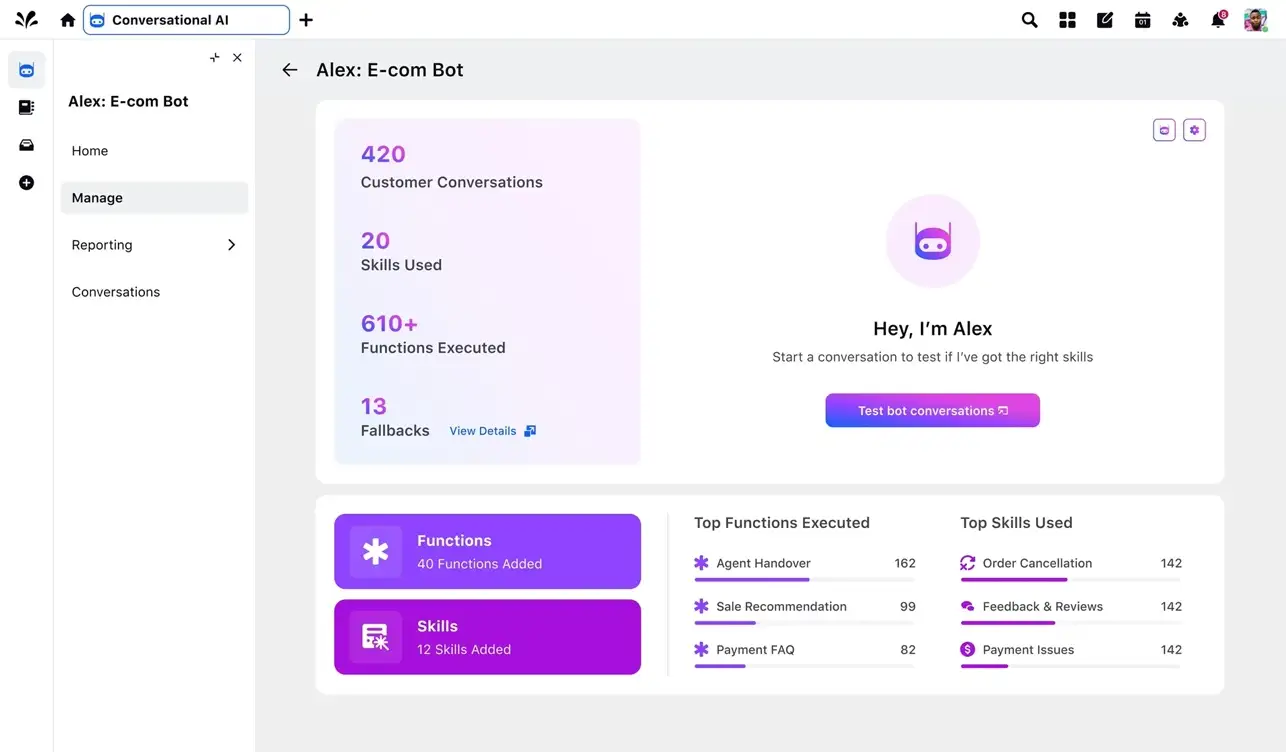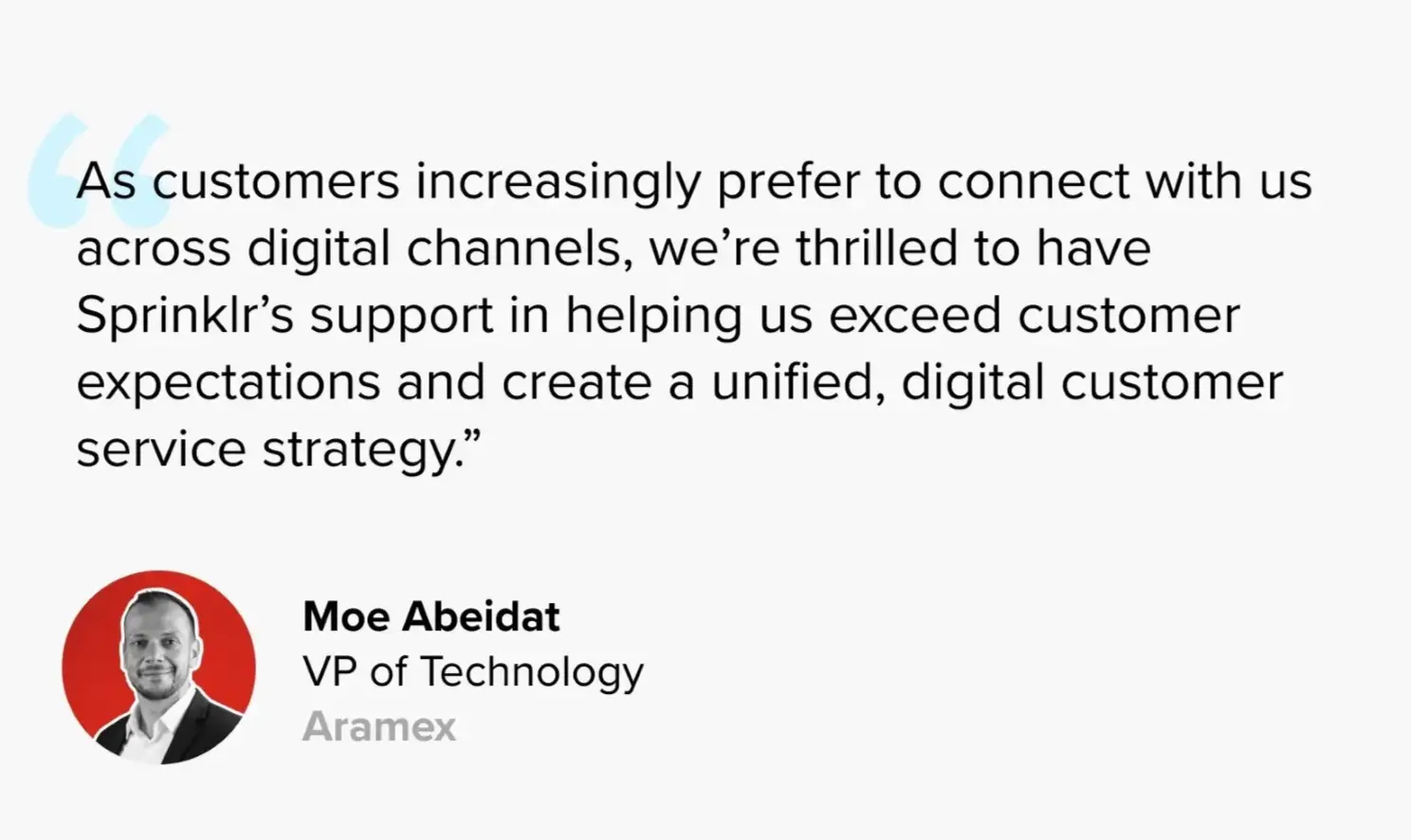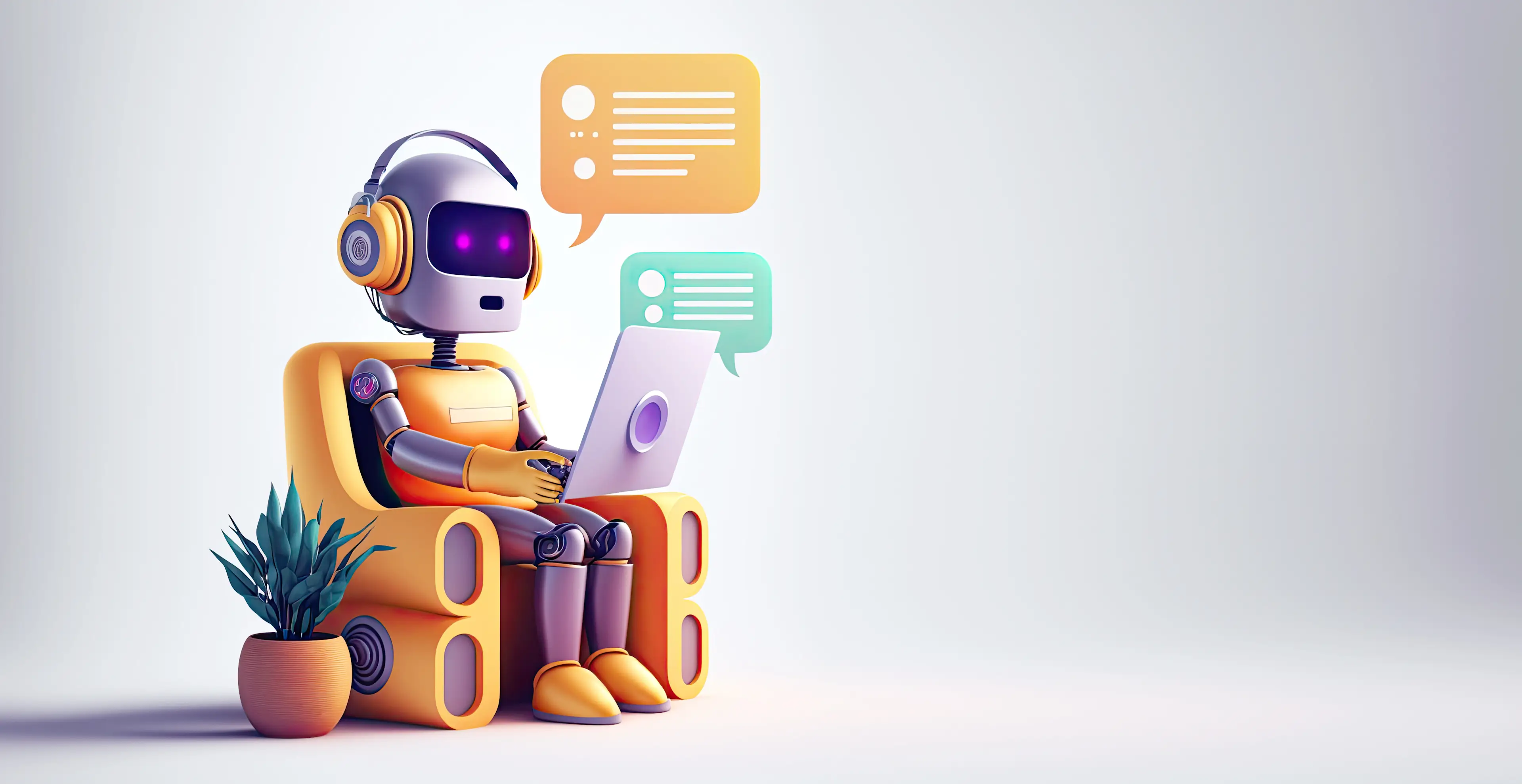The next generation of CCaaS is here
Digital-first customer service, enterprise-scale voice support. Redefine customer service with an AI-powered platform that unifies voice, digital and social channels. Power channel-less interactions and seamless resolution no matter the channel of contact.

Why Every Business Needs an Enterprise Chatbot
In today's fast-paced business environment, enterprise chatbots are revolutionizing customer service. According to Juniper Research, the chatbot market is projected to grow from $12 billion in 2023 to $72 billion by 2028. These AI-driven tools not only enhance customer engagement but also significantly reduce operational costs. As Brett Pitts, EVP at Wells Fargo, notes, "Chatbots are transforming customer interactions, making them more efficient and personalized."
For customer service leaders, integrating chatbots means staying ahead of the curve, improving response times, and delivering superior customer experiences. Are you ready to embrace this technology to drive your enterprise forward? Let’s discuss.
What are enterprise chatbots?
Enterprise chatbots are AI-powered bots that enable large businesses to answer customer questions, automate tasks and deliver conversational customer service. Their data collection, retrieval capacity and personalization is much enhanced than regular chatbots, which makes them a valuable customer support tool for enterprises.
Moreover, enterprise chatbots render themselves to extreme customization to suit the brand's unique business needs and tech stack. They can be integrated with third-party applications for CRM, ticketing, knowledge management and helpdesk solutions.
Much like standard chatbots, enterprise bots are either AI-powered, rule-based or a hybrid of AI and rules. However, they can solve more complex, multistep and multilingual customer issues, without experiencing any latency or downtime.
Key characteristics of enterprise chatbots
Enterprise chatbots are transforming customer service with their advanced capabilities. Here are some key characteristics:
1. Artificial intelligence (AI)
AI-powered chatbots for customer service simulate human-like interactions, making conversations more natural and engaging. This technology helps chatbots process data, recognize patterns, and make real-time decisions, ensuring efficient and accurate responses.
💡Insights Corner
Generative AI (GenAI) will be a part of 80% of conversational AI offerings in 2026, a significant increase from 20% in 2023 - Gartner
2. Machine learning (ML)
Machine learning enables chatbots to learn from past interactions and continuously improve. By analyzing previous conversations, chatbots refine their algorithms to provide better solutions over time, reducing errors and increasing accuracy.
3. Natural language processing (NLP)
NLP allows chatbots to understand and interpret human language. This technology helps chatbots comprehend the context and nuances of customer queries, enabling them to respond appropriately and engage in meaningful conversations.
👉Recommended Read: The Role of NLP in Customer Service
4. Personalization
Chatbots can personalize interactions by leveraging AI, ML, and NLP. They analyze customer data to tailor responses based on individual preferences and past interactions, enhancing the customer experience and increasing satisfaction.
5. Continuous improvement
Chatbots gather data from each interaction to improve their performance. Machine learning algorithms analyze this data to update the chatbot's knowledge base ensuring they remain up-to-date and effective in handling new types of queries.
6. Scalability
Chatbots can handle multiple interactions simultaneously, making them highly scalable. They maintain consistent performance during peak times, such as holiday seasons or promotional events, without compromising service quality.
7. 24/7 Availability
Chatbots operate around the clock, providing assistance whenever needed. This 24/7 availability improves customer satisfaction and helps businesses capture leads and address issues promptly
Why enterprises are adopting chatbots
Enterprise businesses are increasingly turning to chatbots for a variety of compelling reasons. Here are the key benefits driving this adoption:
💰Business benefits for enterprises
1. Cost savings
Chatbots significantly reduce operational costs by automating routine tasks that would otherwise require human intervention. This automation allows businesses to allocate resources more efficiently, reducing the need for large customer service teams and lowering overall expenses.
Conversational AI applications (like gen AI bots) will slash contact center agent labor costs by a whopping $80 Billion in 2026. - Gartner
2. Operational efficiency
Chatbots streamline operations by handling multiple interactions simultaneously. This scalability ensures that businesses can manage high volumes of customer inquiries without compromising on service quality.
3. Data collection and analysis
Chatbots gather valuable data from interactions, which can be analyzed to gain insights into customer behavior and preferences. This data helps businesses make informed decisions and improve their services.
4. Internal communication
Chatbots can facilitate internal communication by providing instant access to information and resources. They can help employees find documents, schedule meetings, and stay updated on company policies.
5. Administrative task automation
Chatbots can assist with administrative tasks, such as employee onboarding, answering employee queries, and managing schedules. This automation frees up HR staff to focus on more strategic initiatives.
Helpful Read: Chatbot Analytics: What Metrics Matter for Your ROI
😀 Customer-facing benefits for enterprises
1. Personalized interactions
Chatbots can tailor responses based on individual customer data, creating a more personalized and engaging experience.
2. Consistency
Chatbots provide consistent responses, ensuring that all customers receive the same high level of service.
3. Quick resolutions
With their ability to handle multiple queries simultaneously, chatbots reduce wait times and provide faster resolutions.
4. 24/7 availability
One of the most attractive features of chatbots is their ability to operate around the clock. Unlike human agents, chatbots can provide assistance at any time of day or night, ensuring that customers receive timely support regardless of time zones or business hours.
5. Enhanced customer experience
Chatbots improve the customer experience by providing instant, accurate responses to queries. They can handle a wide range of customer interactions, from answering frequently asked questions to processing orders and providing personalized recommendations.
Top features of enterprise chatbots
Enterprise chatbots are designed to meet the complex needs of large organizations. Here are some of the top features that make them suitable for such environments:
1. Multilingual support for global operations
Enterprise chatbots often come with multilingual capabilities, allowing them to interact with customers in multiple languages. This feature is crucial for global businesses that serve a diverse customer base.
2. Integration with business tools and systems
A key feature of enterprise chatbots is their ability to integrate seamlessly with existing business tools and systems. This includes customer relationship management (CRM) software, enterprise resource planning (ERP) systems, and other essential business applications.
Such integrations enable chatbots to access and utilize relevant data, streamline workflows, and provide more accurate and personalized responses to customer queries.
3. Data analytics and reporting
Enterprise chatbots are equipped with advanced data analytics and reporting capabilities. They can collect and analyze data from customer interactions to generate valuable insights. These insights help businesses understand customer behavior, identify trends, and make informed decisions.
Additionally, detailed reports on chatbot performance can highlight areas for improvement, ensuring continuous optimization of customer service operations.
4. Scalability
Enterprise chatbots are designed to handle high volumes of interactions simultaneously, making them highly scalable. This scalability ensures that businesses can maintain consistent service quality even during peak times, such as product launches or holiday seasons. Chatbots can efficiently manage large numbers of customer queries without compromising on response times or accuracy.
Invest in genAI-powered bots that are miles ahead of traditional bots in terms of scalability, customization, intent discovery, and time to market.
For example, Sprinklr’s GenAI-powered conversational AI platform offers:
- No-code 3-step bot builder
- Build-once-deploy across 25+ channel bots
- Supports 100+ languages
- 250+ ready-to-use bot templates for industry use cases

5. Security and compliance
Customer service security is a top priority for enterprise chatbots. They are built with robust security features to protect sensitive customer data and ensure compliance with industry regulations. This includes encryption, secure data storage, and regular security updates. By maintaining high security standards, chatbots help businesses build trust with their customers.
6. Personalization
Enterprise chatbots leverage AI and machine learning to deliver personalized interactions. By analyzing customer data, chatbots can tailor their responses to individual preferences and past interactions. This personalization enhances the customer experience, making interactions more relevant and engaging.
7. Omnichannel support
Enterprise chatbots can operate across multiple channels, including websites, mobile apps, social media platforms, and messaging apps. This omnichannel support ensures that customers can reach out for assistance through their preferred communication channels, providing a seamless and consistent experience.
Sprinklr’s chatbots are enterprise-ready with unmatched channel coverage and multilingual support. Check it out here:
5 best use cases of conversational enterprise chatbots
Enterprise chatbots can be leveraged in many ways to add agility and security to interactions and optimize user experience. Here are five top applications:
1. Customer query and complaint resolution
Enterprise chatbots provide uninterrupted customer support by handling multiple conversations across geographies, languages, and products. They can manage massive customer data, answer technical questions, troubleshoot issues, and seek feedback without increasing agent headcount or service costs. In fact, according to IBM, chatbots can answer almost 80% of all standard questions.
Chatbots detect user intent, maintain context, and seamlessly hand off complex cases to live agents, ensuring a smooth and satisfying user experience.
👑Success Story: How Aramex Scales Live Support with Chatbots
The Dubai-based logistics provider uses Sprinklr’s Conversational AI to manage customer inquiries in multiple languages across various digital channels. This implementation supports over 400 customer agents, improving efficiency and productivity.

2. Lead generation and nurture
Enterprise chatbots handle sales and lead generation across digital touchpoints like websites, social media, and messaging platforms. Using AI and natural language processing, they gauge purchase intent, qualify leads, capture user information, and facilitate upselling and cross-selling.
Chatbots help sales and marketing teams by scoring leads, capturing contact details, and promoting relevant products and offers.
3. Internal helpdesk support
Chatbots assist internal teams by sourcing relevant knowledge base articles and providing quick access to company policies, product information, and leave calendars. They answer frequently asked questions and support new hires with onboarding processes.
HR bots handle mundane tasks like leave approval and benefits enrollment, allowing teams to focus on more strategic activities.
4. Customer onboarding and implementation
Chatbots help new customers configure and use products/services by providing integrated explainer videos, troubleshooting technical issues, and redirecting users to relevant manuals.
They ensure early positive experiences, building loyalty and customer retention. If issues require human intervention, chatbots can schedule callbacks or continue the conversation later, keeping users engaged.
5. Data retrieval and insights
Enterprise chatbots deliver real-time business data and insights. For example, a financial director might use a chatbot for stock market updates, while a logistics company could schedule deliveries based on real-time traffic insights.
Chatbots make dashboards, KPIs, and performance metrics accessible, helping businesses make informed decisions.
By leveraging these use cases, enterprises can enhance customer support, drive sales, improve internal processes, and gain valuable insights, ultimately boosting efficiency and satisfaction.
How to choose the right enterprise chatbot for your business
Selecting the right enterprise chatbot for your business is a critical decision that can significantly impact your customer service and operational efficiency. To make an informed choice, you can evaluate chatbot platforms based on Forrester's criteria for Digital Customer Interaction Solutions (DCIS) vendors. These criteria are grouped into three main categories: current offering, strategy, and market presence.
#1. Current offering
This category focuses on the features and capabilities of the chatbot platform. Key aspects to consider include:
· Integration capabilities: Check if the chatbot can integrate seamlessly with your existing business tools and systems, such as CRM, ERP, and helpdesk software. Effective integration enables the chatbot to access relevant data and streamline workflows.
· User experience: Evaluate the chatbot's user interface and ease of use. A user-friendly platform ensures smooth setup, management, and operation, enhancing both customer and employee experiences.
· Range of digital interaction channels supported: Ensure the chatbot can operate across multiple channels such as websites, mobile apps, social media platforms, and messaging apps. This omnichannel support is crucial for providing a seamless customer experience.
#2. Strategy
This category assesses the vendor's vision, roadmap, and ability to execute its strategy effectively. Consider the following:
· Vendor's vision and innovation: Look for a vendor with a clear vision for the future and a commitment to innovation. This includes staying ahead of technological advancements and continuously improving their chatbot solutions.
· Roadmap and execution: Evaluate the vendor's product roadmap and their track record of delivering on promises. A reliable vendor should have a well-defined plan for future updates and enhancements.
· Market approach: Consider the vendor's approach to the market, including their customer engagement strategies and support services. A vendor with a strong market presence and customer-centric approach is more likely to provide reliable and effective solutions.
#3. Market presence
This category looks at the vendor's market share, customer base, and overall presence in the market. Key factors include:
· Market share: Assess the vendor's position in the market. A vendor with a significant market share is likely to have a proven track record and a robust customer base.
· Customer base: Look at the size and diversity of the vendor's customer base. A wide range of satisfied customers across different industries indicates the vendor's ability to meet various business needs.
· Overall presence: Consider the vendor's reputation and presence in the industry. This includes their participation in industry events, thought leadership, and recognition by analysts and experts.
By evaluating chatbot platforms based on these criteria, you can select the right enterprise chatbot that aligns with your business goals and enhances your customer service and operational efficiency. If you have any specific questions about the criteria or need more details, feel free to ask!
Future of enterprise chatbots in 2025 and beyond
As we look towards 2025 and beyond, the evolution of enterprise chatbots is set to revolutionize business interactions even further. Here are some key trends and advancements to watch out for:
A) Conversational AI
The integration of advanced conversational AI will enable chatbots to engage in more natural and intuitive interactions. These AI-driven bots will understand context better, handle complex queries, and provide more accurate and personalized responses. This will enhance customer satisfaction and streamline business processes.
👑Success Story: How the U.S. Census Bureau Improves Citizen Services Via Chatbots
The U.S. Census Bureau has partnered with Sprinklr to launch conversational AI bots on Facebook and X (formerly Twitter) to handle inbound queries and online chatter from citizens regarding policies related to education, awareness and efficiency.
Curious? Hit the button below to find out more.
B) Voice bots
Voice-enabled chatbots are becoming increasingly popular, allowing users to interact with businesses through voice commands. This trend is expected to grow, providing a hands-free, convenient way for customers to get support and information. Voice bots will be particularly useful in industries like healthcare, automotive, and smart home devices.
Related Read: Voice Bots vs. Chatbots
C) Deep integration with business processes
Future chatbots will be deeply integrated with various business processes, from customer service to HR and beyond. This integration will enable chatbots to access and utilize data from multiple sources, providing more comprehensive and efficient solutions. For example, chatbots will assist in automating workflows, managing inventory, and even conducting market research.
Check out Sprinklr's exhaustive list of Integrations here.
D) Enhanced security and compliance
As chatbots handle more sensitive data, security and compliance will become even more critical. Future chatbots will incorporate advanced security measures, such as encryption and multi-factor authentication, to protect user data and ensure compliance with regulations like GDPR and CCPA.
Build future-ready enterprise chatbots with Sprinklr
In an age where instant responses are expected, businesses can’t do without enterprise chatbots. These tools improve employee productivity, enhance customer experience, and support troubleshooting tasks anytime. Sprinklr Service offers both live chat and conversational AI platforms, supporting contextual, omnichannel, and multilingual conversations to improve resolution rates.
Some key features of Sprinklr’s Conversational AI include:
1. Customized brand voice: Tailor the chatbot’s voice to match your brand tone and guidelines.
2. Seamless integrations: Connect with CRM and knowledge base systems to access relevant information and manage customer data.
3. Integrated self-service: Use FAQs, knowledge articles, automated workflows, and conversational AI bots to handle basic queries, saving time for agents.
Contact Sprinklr today for a free demo and explore how our Conversational AI can meet your unique business needs.
Frequently Asked Questions
Enterprise chatbots offer advanced features like scalability, integration with business systems, and multilingual support, making them suitable for large organizations with complex needs.
Yes, enterprise chatbots can handle sensitive financial transactions with robust security measures like encryption and multi-factor authentication to ensure data protection and compliance.
Maintenance includes regular updates, performance monitoring, security checks, and occasional retraining of AI models to ensure the chatbot remains effective and secure.
Implementation time varies but typically ranges from a few weeks to a few months, depending on the complexity of the integration and customization required.
Yes, enterprise chatbots can manage multi-step workflows, guiding users through processes like order tracking and troubleshooting with ease and efficiency.


